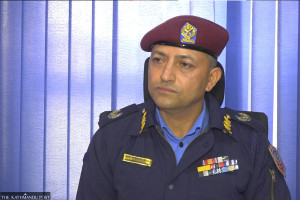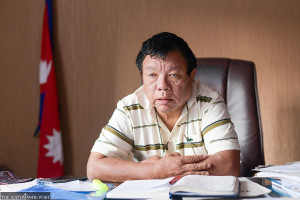Interviews
Building sustainable cities allows governments to invest in rural areas
When the provinces are weak, there is a need for a separate entity in order to facilitate, coordinate and deliver service at the metropolitan level.
Biswas Baral
As Global Director for the Urban, Resilience and Land Global Department at the World Bank, Ming Zhang leads the bank’s global efforts on sustainable urban development, disaster risk management, and land. Ming Zhang, who has had the experience of working all over the world, including in Nepal, holds a PhD in City and Regional Planning from the University of California, Berkeley. In this conversation with the Post’s Biswas Baral, he discusses the challenges of urbanisation in developing countries, sustainable development of cities, and Nepal’s urban development status.
The World Bank has just come out with its Banking on Cities report on ways to make cities in lower and middle income countries more resilient and sustainable. How would you summarise its findings?
The first point is that the cities are very important for economic growth, for the jobs. Around 80 percent of private sector jobs are created in cities. And all the countries, from low to high income ones, go through the urbanisation process. So this is an important topic. The second point is the financing needs for cities to become economically viable and climate resilient. It’s quite big. From the report, we estimate the annual financing needs for urban infrastructure in lower and middle income countries to be between 0.8 to 2.6 percent of GDP of these countries.
So there is a big range. The cities’ ambitions could be different, the impact of climate change on them could be different, and also the ways countries and cities plan urban development. Hence there is also a range of financing needs.
The third point is that countries and cities can do things to meet their financing needs. The new report focuses on three areas to cover the financing. The first is what we call funding, basically the revenue streams you need to have on a regular basis to fund basic services and the development. This includes the revenue from the cities themselves, such as property taxes or other user fees. Or it could be fiscal transfer from the national government. Or it could be other kinds of sources, for example, carbon credit that can also be regular funding sources. So these are your revenue sources.
Based on these funding sources, you come up with financing, the chunky capital investments you need up front to have the infrastructure. The financing will be based on the funding.
You go through the capital market, you take debt or make PPP arrangements from the public side, from international financial institutions, but also from the private financial markets. That's the second part.
The third part is looking at the efficiency gains from how you do urban development. If you do it in a more compact way, with good spatial planning, the cost is lower. You can do investment planning in a way that lowers the cost.
Basically, you need to strengthen your financing stream, you need to be efficient in how you do urban development, lower the cost, and then with that you can tap into the financial market for investment funds.
Let me give the example of my own country, Nepal, which has six metropolitan cities and 11 sub-metropolitan cities. Most of these entities cannot even spend half their allotted budget. Corruption is high. How can such cities look to develop sustainably in the long run?
You raised multiple issues. One is the capacity of the local governments to plan, prepare, and implement projects. Not just in Nepal, even in other countries, there’s a lot of capacity bottleneck at the local level. Even when you have the funding, local governments cannot make good use of them. You also mentioned governance challenges. You want to make sure the money is spent well. These issues are linked. On the issue of capacity constraint, I know Nepal is undergoing a process of decentralisation. So you take resources to the grassroots, and you try to increase accountability at the local government level. That is an important part of the regulatory framework you need to have at the national level; to create accountability at two levels.
One is upward accountability to the central government. For fiscal transfers to the local government, you need to meet accounting standards, procurement, financial management, transparency standards. That’s the upward accountability.
But downward accountability is as important in that local governments should be accountable to the citizens. They must be transparent, on the money being raised as tax revenue, on what is coming from the centre, and how they are spending the money to improve the services. But who ensures this accountability? Usually this is spelled out in the decentralisation framework. National governments have administrative and fiscal regulations on these issues.
Also, in Nepal, the heads of local governments are elected. This election process also is one way to ensure accountability to the citizens.
Again, if you look at Nepal, its funding capacity is low but the needs are high. But politicians, as elsewhere, want to build gleaming infrastructures to appeal to their constituencies. In this quest, the questions of sustainability and climate resilience get low priority. How do you address this challenge?
In Nepal, there is a shortage of infrastructure. Whether it’s transport, water supply, sanitation or waste—there’s a serious gap in the infrastructure. More investment is needed for infrastructure, particularly in Kathmandu Valley, which is really the engine of growth for the whole country, and expanding fast. But the infrastructure is not sufficient.
Second, you also need institutions to manage whatever investments are made. Because these investments quite often need sustained service delivery. If you invest in water supply, it’s not just about pipes. You actually need to make sure, for example, that the water supply continues on a daily, hopefully, 24-7 basis.
Either utilities or municipalities must have that institutional accountability. Simple things like keeping the streets clean and collecting garbage, you need institutions to implement those things. So financing these institutions is important.
The third part in the context of the quickly-urbanising Kathmandu Valley is lack of advanced planning. Often, you don’t have a plan even as the urban expansion is happening very fast. So you have houses and buildings all over the places, commercial centres all over the places. And once they are built, it's very difficult to change it, to retrofit.
The other part of the plan related to the climate side are risk areas, whether it’s related to flooding or other kinds of risk where there should be no building. And you have that restriction. Because you shouldn’t build in flooding areas. But these also tend to be areas where the land is the cheapest. So people just build. And once you build, there is flooding and it becomes the government’s responsibility.
But what happens if the infrastructure is already built? For instance, in Kathmandu, there’s absolutely no empty space now. How is sustainable development possible in a place like that?
I think there are two approaches. One, again, the city is expanding very fast. Can we do something more in the areas that are being newly developed? Instead of repeating what you have been doing, in the new expansion area, try to do a bit more advanced planning, and that's much easier to do than in the urban area where the population density is high. And because you're urbanising very fast, in the next 20 to 30 years, probably the urban area of Kathmandu Valley will double. So half the possible urban areas are still empty.
So in new areas, how do we plan expansion? That’s something important to look at. Then in the old area, existing urban areas, how can you retrofit to do some urban regeneration? Again, there are different experiences in different countries. There is no universal formula. It’s location specific.
Land is tight. You look where the land can be used. Are there some government land that’s not being used efficiently? Where is private land? Where can you do some consolidation? Where in the existing area can do higher density development and leave other areas for land readjustment. There are different models you may be able to tap into for urban regeneration for the existing areas.
One of the big problems in Nepal is that our villages are emptying. The youths are leaving and only some elderly are left behind. Most of these youths come to the cities or go abroad. So does this focus on urbanisation and urban development also destroy the countryside?
I think the development of urban centres and the countryside can go hand in hand. One focus of financing for the urban service is that you try to have more investment and service delivery needs coming from the cost recovery scheme, using land value or user fees or property tax. So you reduce the burden on the national government as urban spaces have more potential to raise finances. The savings can then be invested in rural areas.
Even if young people move out, you still need to provide services in those rural areas, and the national government is responsible for it.
In the urban areas, there are poor too who need the support of the national government and the local government. But, again, a lot of the service needs in the urban areas can be covered from what we call repayable financing through use of fees, taxes, and other charges of the land value capture, so that you reduce the burden on the national government for the service needs.
Talking about sustainable development of the cities, are there low-hanging fruits that cities can easily do, especially those in poor and middle-income countries?
On the low-hanging fruits, what the cities do differs from place to place. For example, one major source of revenue for local governments across the world is property tax. Quite often, a lot of the cities are supposed to have the property tax system, but then they don’t actually have a system to send out the bills. In some places, it’s not clear where to pay.
Paying property tax could be complicated. So even if you just set up a simple billing system and facilitate the payment, you can actually increase tax collection by a lot.
We have a property tax assessment tool to look at what other systems you have and where the gaps are. I think, again, on the planning side, it doesn't necessarily cost a lot of money.
But especially in a new expansion area, if you do some planning, this is actually going to reduce the cost of infrastructure investment in the future. What’s even more important is that it’s very good for the private landowners.
If people know this major road is going to be built here, I can accordingly invest in my private property. It’s good for the private landowner and for private development. The planning side is something that doesn't necessarily cost money.
Our country was a unitary state, and now we are a federal state. We now have three tiers of government: federal, provincial, local government. The local level is a bit active, the provincial level is not working at all, and most things are still centralised at the federal level. In urban planning, what specific role do these entities have, and which one should take the lead?
This varies a lot from country to country. And there are advantages and disadvantages of different systems. For example, India and Pakistan have a system where the state or province have a very strong role. Other countries like Brazil and Indonesia have stronger local governments, to some extent independent from the state level entities. In Nepal, as you mentioned, the provincial level, as designed right now, is not strong. In this kind of system, you see the local governments have stronger accountability, because the mayors are often the face of the cities.
In countries where the province level is strong, you don't see the mayors. They don't have a strong role. But in countries like Nepal, the mayors are very strong, and in many ways, they have more accountability, political pressure to deliver.
But you can have issues in a big urban area like Kathmandu Valley which has as many as 25 municipalities. This is where planning, implementation become complicated, because the road system, the transport system need to be connected. The land use plan needs to be connected. In this kind of system, you need some kind of entity, whether it’s provincial or metropolitan management entity, which tries to manage this cross-municipal, inter-jurisdiction, inter-municipal issues at the urban region level. When the province is weak, there is a need to have that kind of entity to do facilitation, coordination and even service delivery at the metropolitan level.




 17.12°C Kathmandu
17.12°C Kathmandu











%20(1).jpg&w=300&height=200)

